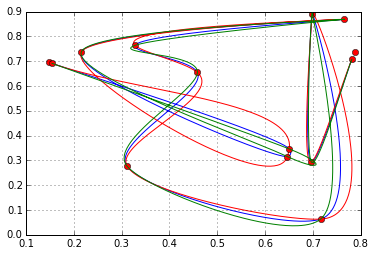As mentioned previously you do need 4 points for catmull-rom, and the endpoints are an issue. I was looking at applying these myself instead of natural cubic splines (which the potential overshoots beyond the known data range is impractical in my application). Similar to @denis's code, here is something that might help you (notice a few things. 1) That code just randomly generates points, I'm sure you can use the commented out examples for how to use your own data. 2) I create extended endpoints, preserving the slope between the first/last two points - using an arbitrary distance of 1% of the domain. 3)I include uniform, centripetal, and chordial knot parameterization for comparison):
![Catmull-Rom Python Code Output Example Image]()
# coding: utf-8
# In[1]:
import numpy
import matplotlib.pyplot as plt
get_ipython().magic(u'pylab inline')
# In[2]:
def CatmullRomSpline(P0, P1, P2, P3, a, nPoints=100):
"""
P0, P1, P2, and P3 should be (x,y) point pairs that define the Catmull-Rom spline.
nPoints is the number of points to include in this curve segment.
"""
# Convert the points to numpy so that we can do array multiplication
P0, P1, P2, P3 = map(numpy.array, [P0, P1, P2, P3])
# Calculate t0 to t4
alpha = a
def tj(ti, Pi, Pj):
xi, yi = Pi
xj, yj = Pj
return ( ( (xj-xi)**2 + (yj-yi)**2 )**0.5 )**alpha + ti
t0 = 0
t1 = tj(t0, P0, P1)
t2 = tj(t1, P1, P2)
t3 = tj(t2, P2, P3)
# Only calculate points between P1 and P2
t = numpy.linspace(t1,t2,nPoints)
# Reshape so that we can multiply by the points P0 to P3
# and get a point for each value of t.
t = t.reshape(len(t),1)
A1 = (t1-t)/(t1-t0)*P0 + (t-t0)/(t1-t0)*P1
A2 = (t2-t)/(t2-t1)*P1 + (t-t1)/(t2-t1)*P2
A3 = (t3-t)/(t3-t2)*P2 + (t-t2)/(t3-t2)*P3
B1 = (t2-t)/(t2-t0)*A1 + (t-t0)/(t2-t0)*A2
B2 = (t3-t)/(t3-t1)*A2 + (t-t1)/(t3-t1)*A3
C = (t2-t)/(t2-t1)*B1 + (t-t1)/(t2-t1)*B2
return C
def CatmullRomChain(P,alpha):
"""
Calculate Catmull Rom for a chain of points and return the combined curve.
"""
sz = len(P)
# The curve C will contain an array of (x,y) points.
C = []
for i in range(sz-3):
c = CatmullRomSpline(P[i], P[i+1], P[i+2], P[i+3],alpha)
C.extend(c)
return C
# In[139]:
# Define a set of points for curve to go through
Points = numpy.random.rand(10,2)
#Points=array([array([153.01,722.67]),array([152.73,699.92]),array([152.91,683.04]),array([154.6,643.45]),
# array([158.07,603.97])])
#Points = array([array([0,92.05330318]),
# array([2.39580622,29.76345192]),
# array([10.01564963,16.91470591]),
# array([15.26219886,71.56301997]),
# array([15.51234733,73.76834447]),
# array([24.88468545,50.89432899]),
# array([27.83934153,81.1341789]),
# array([36.80443404,56.55810783]),
# array([43.1404725,16.96946811]),
# array([45.27824599,15.75903418]),
# array([51.58871027,90.63583215])])
x1=Points[0][0]
x2=Points[1][0]
y1=Points[0][1]
y2=Points[1][1]
x3=Points[-2][0]
x4=Points[-1][0]
y3=Points[-2][1]
y4=Points[-1][1]
dom=max(Points[:,0])-min(Points[:,0])
rng=max(Points[:,1])-min(Points[:,1])
pctdom=1
pctdom=float(pctdom)/100
prex=x1+sign(x1-x2)*dom*pctdom
prey=(y1-y2)/(x1-x2)*(prex-x1)+y1
endx=x4+sign(x4-x3)*dom*pctdom
endy=(y4-y3)/(x4-x3)*(endx-x4)+y4
print len(Points)
Points=list(Points)
Points.insert(0,array([prex,prey]))
Points.append(array([endx,endy]))
print len(Points)
# In[140]:
#Define alpha
a=0.
# Calculate the Catmull-Rom splines through the points
c = CatmullRomChain(Points,a)
# Convert the Catmull-Rom curve points into x and y arrays and plot
x,y = zip(*c)
plt.plot(x,y,c='green',zorder=10)
a=0.5
c = CatmullRomChain(Points,a)
x,y = zip(*c)
plt.plot(x,y,c='blue')
a=1.
c = CatmullRomChain(Points,a)
x,y = zip(*c)
plt.plot(x,y,c='red')
# Plot the control points
px, py = zip(*Points)
plt.plot(px,py,'o',c='black')
plt.grid(b=True)
plt.show()
# In[141]:
Points
# In[104]:

